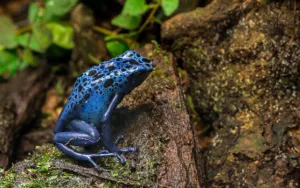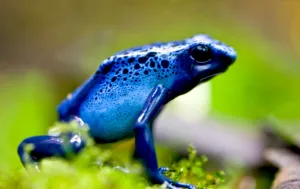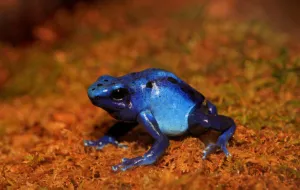
Table of Contents
Scientific Classification
- Kingdom: Animalia
- Phylum: Chordata
- Class: Amphibia
- Order: Anura
- Family: Dendrobatidae
- Genus: Dendrobates
- Species: Various species, including Dendrobates azureus
Quick Overview
The Blue Poison Dart Frog (Dendrobates azureus) is a striking amphibian known for its vibrant blue coloration and fascinating behaviors. Native to the rainforests of Central and South America, these frogs belong to the family Dendrobatidae, which includes several species with varying color patterns and toxicities.
Fast Facts
- Scientific Name: Dendrobates azureus
- Lifespan: 4 to 6 years in the wild
- Average Size: Typically 1 to 2 inches in length
- Diet: Insectivorous, consuming small invertebrates
- Habitat: Tropical rainforests, especially in leaf litter and vegetation
- Conservation Status: Least Concern
Did you know?
The bright colors of the Blue Poison Dart Frog serve as a warning to potential predators about its toxicity.
Appearance
The Blue Poison Dart Frog is renowned for its stunning azure blue coloration, which acts as a visual deterrent in the animal kingdom. The vibrant blue skin is accented by contrasting black markings, creating a distinctive and beautiful appearance.
Size
These small frogs are generally 1 to 2 inches in length, making them relatively small in size. Their diminutive stature, coupled with their vivid colors, contributes to their visual impact in their natural habitat.
Temperament and Behavior
Known for their diurnal and bold nature, Blue Poison Dart Frogs are active during the day. They display intricate courtship rituals, and their toxicity is attributed to their diet in the wild, which includes certain ants and mites.
Fun Fact
The toxins present in the skin of Blue Poison Dart Frogs are thought to be derived from their diet in the wild, specifically from consuming alkaloid-containing arthropods.
Habitat and Distribution
These frogs primarily inhabit the tropical rainforests of Central and South America, favoring areas with high humidity and abundant leaf litter. Their distribution spans countries like Brazil, Suriname, and Guyana.
Care Guide
While captivating, Blue Poison Dart Frogs are not recommended as pets for beginners due to their specific care requirements. In captivity, they need a well-designed vivarium that mimics their natural habitat, with appropriate humidity, temperature, and hiding spots.
Diet and Nutrition
Blue Poison Dart Frogs are insectivores, preying on small invertebrates like ants, termites, and mites. In captivity, a diet of fruit flies, pinhead crickets, and other small prey items is essential for their health.
Health and Wellness
Maintaining optimal conditions in their enclosure, including proper humidity and a balanced diet, is crucial for the well-being of Blue Poison Dart Frogs. Regular monitoring helps prevent health issues.

Reproduction
Breeding behavior involves elaborate courtship rituals, and the male protects the eggs until they hatch. Tadpoles are then transported to water by the male, where they undergo metamorphosis.
Conservation Status
The Blue Poison Dart Frog is currently listed as Least Concern by the International Union for Conservation of Nature (IUCN). However, habitat loss and potential threats from the pet trade warrant ongoing conservation efforts.
Fun Fact
While their toxicity is a defense mechanism, Blue Poison Dart Frogs raised in captivity and isolated from their natural diet do not develop the same level of toxicity as those in the wild.
Photo Gallery




Related Profiles
- Golden Poison Dart Frog
- Strawberry Poison Dart Frog
- Dyeing Poison Dart Frog
Fun Fact
Blue Poison Dart Frogs engage in intricate courtship displays, including vocalizations and physical movements, as part of their reproductive behavior.
- Enchi Ball Python: A Unique and Stunning Morph of Python regius - March 27, 2025
- Emerald Tree Monitor: The Enigmatic Green Guardian of the Rainforest - March 26, 2025
- The Egyptian Cobra (Naja haje): A Fascinating Serpent - March 25, 2025
